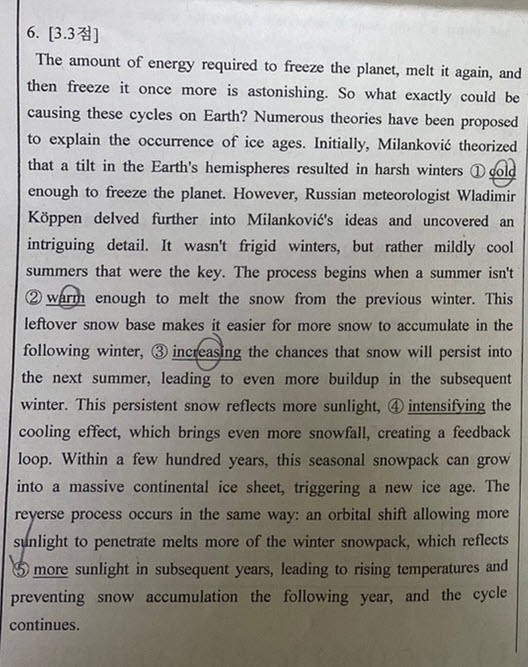대구외고 1학년 2학기 중간고사 시험분석(심화영어)-(2)
이상엽 쌤은 대구외고 수험생들을 위해 선생님들의 출제경향을 정확히 분석해 맞춤예상 문제를 제공합니다. 영어가 어렵고, 막막해서 공부 어디서 할까 고민이면, 찍신 이상엽 쌤을 찾으세요! 수업문의 010 2818 6994
학교 출제 문제 / 찍신 쌤 출제 문제 <비교>
심화영어 6번 (낱말의 쓰임)

찍신 쌤 시험대비 출제 문제
[77~79] 다음 글을 읽고, 물음에 답하시오.
In the early 1900s a Serbian scientist named Milutin Milanković studied the Earth’s position relative to other planets and came up with the theory of ice ages that we now know is accurate: The gravitational pull of the sun and moon gently affect the Earth’s motion and tilt toward the sun. During parts of this cycle—which can last tens of thousands of years—each of the Earth’s hemispheres gets a little more, or a little less, solar (a) radiation than they’re used to.
And that is where the fun begins.
Milanković’s theory initially assumed that a tilt of the Earth’s hemispheres caused (b) ravenous winters cold enough to turn the planet into ice. But a Russian meteorologist named Wladimir Köppen dug deeper into Milanković’s work and discovered a fascinating nuance.
Moderately cool summers, not cold winters, were the icy (c) culprit.
It begins when a summer never gets warm enough to melt the previous winter’s snow. The leftover ice base makes it easier for snow to accumulate the following winter, which increases the odds of snow sticking around in the following summer, which attracts even more accumulation the following winter. Perpetual snow reflects more of the sun’s rays, which (d) exacerbates cooling, which brings more snowfall, and on and on. Within a few hundred years a seasonal snowpack grows into a continental ice sheet, and you’re off to the races.
The same thing happens in reverse. An orbital tilt letting more sunlight in melts more of the winter snowpack, which reflects less light the following years, which increases temperatures, which prevents more snow the next year, and so on. That’s the cycle.
The amazing thing here is how big something can grow from a relatively small change in conditions. You start with a thin layer of snow left over from a cool summer that no one would think anything of and then, in a geological blink of an eye, the entire Earth is covered in miles-thick ice. As glaciologist Gwen Schultz put it: “It is not necessarily the amount of snow that causes ice sheets but the fact that snow, however little, lasts.”
The big takeaway from ice ages is that you don’t need tremendous force to create tremendous results.
If something compounds—if a little growth serves as the fuel for future growth—a small starting base can lead to results so extraordinary they seem to (e) defy logic. It can be so logic-defying that you underestimate what’s possible, where growth comes from, and what it can lead to.
And so it is with money.
77. 윗글의 제목으로 가장 적절한 것을 고르시오.
① Ice Age Shows How Small Financial Growth Can Become Overwhelming Quickly
② Financial Growth Can Mirror the Accumulation of Ice Age Conditions
③ How Small Changes Triggered Earth’s Ice Ages and Financial Growth
78. 윗글의 밑줄 친 (a)~(e)의 문맥상 의미로 적절하지 않은 것은? [2점]
① (a) : emission or propagation of energy in the form of waves or particles
② (b) : extremely hungry
③ (c) : the cause for a problem
④ (d) : to make a problem worse
⑤ (e) : to make something very difficult or impossible
79. 윗글의 내용과 일치하는 것은?
① Milutin Milanković developed a theory in the early 1900s that explained ice ages based on variations in Earth’s orbit and tilt relative to the moon.
② Milanković thought cool summers caused ice ages, but Russian meteorologist Wladimir Köppen refined the theory to show that cold winters were actually the key factor.
③ Whether in Earth’s orbit or in how money is managed can accumulate over time, leading to small changes.
④ Small initial financial growth can compound into significant wealth over time, given the right conditions.
⑤ Both the ice age analogy and financial compounding suggest that we often overestimate how small, consistent actions can lead to extraordinary results over time.
[서술형 15]
윗글의 밑줄 친 If something compounds 가 의미하는 바를 <조건>에 맞게 서술하시오. [5점, 부분점수 있음]
<조건> – 윗글에서 If something compounds 가 빙하기 이론의 맥락에서 지칭하는 문장 1개를 찾아 영어로 적고, 마찬가지로 밑줄 친 If something compounds가 돈에 적용될 때, 무엇을 의미하는 지를 우리말로 설명하시오. |
① 지칭하는 문장
② 돈에 적용할 때 의미
정답 및 해설
77. ③
해설:
[선지해석]
① 빙하기는 작은 금융 성장이 얼마나 빨리 압도적으로 될 수 있는지를 보여준다
② 금융 성장은 빙하기 조건의 축적을 반영할 수 있다
③ 작은 변화가 어떻게 지구의 빙하기와 금융 성장을 촉발했는가
78. ②
해설: ravenous는 극도로 배고프거나 탐욕스러운(extremely hungry or greedy) 뜻이다. 그러나 이 구절의 맥락에서는 추운 겨울이 강렬하고 혹독한(intense and severe) 뜻을 의미한다.
79. ④
[서술형 15]
① 지칭하는 문장
You start with a thin layer of snow left over from a cool summer that no one would think anything of and then, in a geological blink of an eye, the entire Earth is covered in miles-thick ice.
(아무도 생각할 수 없을 만큼 시원한 여름에 남겨진 얇은 눈 층에서 시작하여, 지질학적으로 눈 깜짝할 사이에 지구 전체가 수 마일 두께의 얼음으로 뒤덮인다.)
② 돈에 적용할 때 의미 (모범 답안 2가지)
‘무언가가 복리로 변하면’은 복리 성장의 원리를 말하는데, 이는 처음에 적은 금액이 시간이 지남에 따라 스스로 성장하여 점점 더 큰 결과를 낳는다는 것이다. 금융에서 작고 일관된 변화나 성장이 시간이 지남에 따라 크고 놀라운 결과를 가져올 수 있다는 것을 의미한다.
‘무언가가 복리로 변하면’은 이것은 금융에서 복리의 본질인데, 초기 투자에 대한 이자가 스스로 이자를 낳기 시작하여 기하급수적 성장으로 이어진다. 금융에서 작고 일관된 변화나 성장이 시간이 지남에 따라 크고 놀라운 결과를 가져올 수 있다는 것을 의미한다.
[77~79] 지문요약
Small changes can have big impacts: Both in nature (with ice ages) and in financial growth, even small shifts—whether in Earth’s orbit or in how money is managed—can accumulate over time, leading to massive changes.
(작은 변화는 큰 영향을 미칠 수 있다. 자연(빙하 시대)과 금융 성장 모두에서 작은 변화(지구 궤도나 돈 관리 방식 등)도 시간이 지남에 따라 누적되어 엄청난 변화를 가져올 수 있다.)
[지문해석]
1900년대 초, 세르비아 과학자인 밀루틴 밀란코비치(Milutin Milanković)는 지구의 위치가 다른 행성들과의 관계에서 어떻게 변하는지를 연구했고, 우리가 이제는 정확하다고 알고 있는 빙하기 이론을 제시했습니다. 태양과 달의 중력은 지구의 운동과 태양을 향한 기울기에 미세한 영향을 미칩니다. 이 주기는 수만 년에 걸쳐 일어날 수 있으며, 이 주기의 일부 동안 지구의 각 반구는 평소보다 조금 더 많거나 적은 태양 복사를 받게 됩니다.
그리고 이 지점에서 흥미로운 일이 시작됩니다.
밀란코비치의 이론은 처음에는 지구의 반구가 기울어짐으로 인해 혹독한 겨울이 발생하고, 이로 인해 지구가 얼음으로 뒤덮인다고 가정했습니다. 그러나 러시아 기상학자 블라디미르 쾨펜(Wladimir Köppen)은 밀란코비치의 연구를 더 깊이 파고들어 흥미로운 차이점을 발견했습니다.
겨울의 혹독한 추위가 아니라, 적당히 시원한 여름이 빙하기의 원인이었던 것입니다.
이 과정은 여름이 겨울에 남겨진 눈을 녹이지 못할 때 시작됩니다. 남아있는 얼음층은 다음 겨울에 더 많은 눈이 쌓일 수 있도록 하며, 이는 그다음 여름에도 눈이 더 많이 남아 있을 확률을 높이고, 다음 겨울에는 더 많은 눈이 쌓이게 됩니다. 이렇게 쌓인 눈은 태양의 광선을 더 많이 반사하여 냉각을 가속화하고, 더 많은 눈이 내리는 악순환이 반복됩니다. 몇 백 년 안에 계절적 눈층이 대륙 규모의 빙상으로 자라나고, 이때부터 빙하기가 본격적으로 시작됩니다.
반대로 같은 일이 거꾸로 일어날 수 있습니다. 태양빛이 더 많이 들어오도록 하는 지구의 기울기는 겨울의 눈을 더 많이 녹이게 하고, 그로 인해 그다음 해에 더 적은 빛이 반사되어 온도가 올라가면서 다음 해에도 더 적은 눈이 쌓이게 됩니다. 이렇게 계속되며 빙하기가 끝나게 됩니다. 이것이 바로 주기입니다.
여기서 놀라운 점은 작은 변화로 얼마나 큰 결과가 나올 수 있는가입니다. 시원한 여름에 남겨진 얇은 눈층으로 시작하여, 지질학적으로 짧은 순간 안에 지구 전체가 수 마일 두께의 얼음으로 덮일 수 있습니다. 빙하학자 그웬 슐츠(Gwen Schultz)는 이를 이렇게 표현했습니다. “얼음 시트를 만드는 것은 눈의 양이 아니라, 그 눈이 조금이라도 오래 지속된다는 사실이다.”
빙하기에서 얻을 수 있는 가장 큰 교훈은 엄청난 결과를 만들기 위해서 엄청난 힘이 반드시 필요한 것은 아니라는 점입니다.
무언가가 복리로 성장한다면—작은 성장이 미래 성장을 위한 연료로 작용한다면—작은 출발점에서 출발해도 그 결과는 상상을 초월할 정도로 커질 수 있습니다. 성장이 어디서 오는지, 그리고 그것이 어디로 이어질 수 있는지 과소평가할 수 있을 정도로 그 결과는 논리적으로 이해하기 힘들 정도일 수 있습니다.
돈도 마찬가지입니다.
이상엽 쌤은 대구외고 수험생들을 위해 선생님들의 출제경향을 정확히 분석해 맞춤예상 문제를 제공합니다. 영어가 어렵고, 막막해서 공부 어디서 할까 고민이면, 찍신 이상엽 쌤을 찾으세요! 수업문의 010 2818 6994


